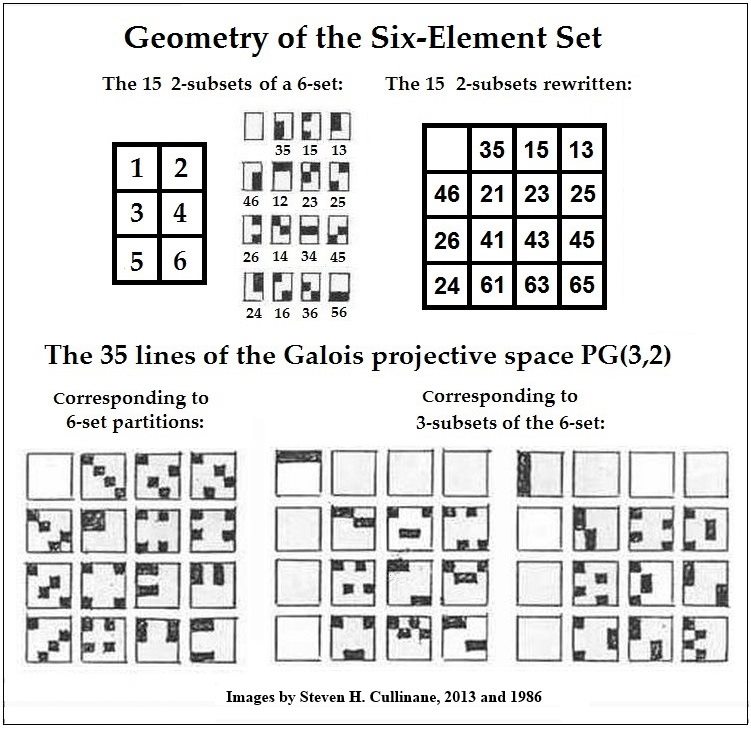A related image search, for Cremona
synthemes, is omitted here,
but one result from the search is retained...
Note particularly the following image:
This is from Inscapes.
Classical Geometry in Light of Galois Geometry The following journal notes discuss the relationship of three frontispiece figures from Baker's Principles of Geometry (six volumes, the first four in 1922-1925) to the Galois projective 3-space PG(3,2). The Rosenhain and Göpel tetrads within PG(3,2) are shown to underlie these figures. The Göpel tetrads underlie the Cremona-Richmond figure that is the frontispiece of Baker's Volume IV (Higher Geometry). The Rosenhain tetrads underlie the figure illustrating Desargues's theorem that is the frontispiece of Baker's Volume I (Foundations). The Göpel tetrads also underlie Baker's frontispiece illustrating Pascal's Hexagrammum Mysticum in Volume II (Plane Geometry). A Galois-geometry key to the mystic hexagram is taken from a May 26, 1986 note on 2-subsets of a 6-set and PG(3,2). The 8-sets (and the associated Galois geometry PG(3,2)) in the Miracle Octad Generator (MOG) of R. T. Curtis turn out be closely related to the Hexagrammum via the 354 configuration of Danzer discussed in a recent paper. The Journal Notes: Sunday, March 31, 2013 (Easter)For PascalA related image search, for Cremona
synthemes, is omitted here, Note particularly the following image: This is from Inscapes. Sunday, March 31, 2013For BakerBaker, Principles of Geometry, Vol. IV (1925), Title:
Baker, Principles of Geometry, Vol. IV (1925), Frontispiece:
Baker's Vol. IV frontispiece shows "The Figure of
fifteen
lines Another such figure in a vector space of four
dimensions
(Some background grid parts were blanked by an image resizing process.) Here the "lines" are actually planes in
the vector 4-space over GF(2), For some background, see today's previous post and Inscapes. Update of 9:15 PM March 31 The following figure relates the above
finite-geometry
Monday, April 1, 2013 Desargues via RosenhainBackground: Rosenhain and Göpel Tetrads in PG(3,2) Introduction
(an update added on April 19, 2013):
A
connection discovered today (April 1, 2013)—
Update of April 18, 2013 Note that
Baker's Desargues-theorem figure has three triangles, (End of April 18, 2013 update.) Update of April 14, 2013 See Baker's
Proof (Edited for the Web) for a detailed explanation (End of April 14, 2013 update.) Update of April 12, 2013 A different figure,
from a site at National
Tsing Hua University, (End of April 12, 2013 update) Update of April 13, 2013 Another in a series
of figures illustrating
See also the original Veblen-Young figure in context. (End of April 13, 2013 update.)
Rota's remarks, while perhaps not completely accurate,
provide
some context For the recent context
of the above finite-geometry version of Baker's Vol.
I For a 1986 illustration of Göpel and Rosenhain tetrads
(though
not under In summary... the following
classical-geometry
figures
Tuesday, April 2, 2013The geometry posts of Sunday and Monday have been Classical Geometry in Light of Galois Geometry. Some background: See Baker, Principles
of Geometry , Vol. II, Note I On Certain Elementary Configurations, and and Vol. II, Note II (pp. 219-236)— On the Hexagrammum Mysticum of Pascal. Monday's
elucidation of Baker's Desargues-theorem figure Such a treatment is by no means new. See Baker's notes "The
Complete Pascal Figure Graphically Presented," What is new in the Monday Desargues post is the graphic See also Cremona's kernel, or nocciolo :
Baker on Cremona's approach to Pascal— "forming, in Cremona's phrase, the nocciolo of the whole."
A related nocciolo : Click on the nocciolo for
some Saturday, April 6, 2013
Pascal
via Curtis
Click image for some background. Shown above is a rearranged version of the The 8-subcell rectangles in the left part of the figure
may be Such a view relates, as the remarks below show, the On Danzer's 354 Configuration:
"Combinatorially, Danzer’s configuration can be
interpreted – Branko Grünbaum, "Musings
on an Example of Danzer's," "Danzer's configuration is deeply rooted in – Marko Boben, Gábor Gévay, and Tomaž Pisanski, For an approach to such configurations that differs from Classical Geometry in Light of Galois Geometry. Grünbaum has written little about Galois geometry. Sunday, April 7, 2013Pascal Inscape
Background: Inscapes and The
2-subsets of a 6-set are the points of a PG(3,2). Tuesday, April 23, 2013The configurations recently discussed in See, in particular— 
The following figures supply the connection of
Henderson's
six-set  Update of August 16, 2013: Click above image for some background from 1986. Related material on six-set geometry from the classical literature— Baker,
H. F., "Note II: On the Hexagrammum
Mysticum of Pascal," Richmond,
H. W., "The Figure Formed from Six
Points in Space of Four Dimensions," Richmond,
H. W., "On the Figure of Six Points
in Space of Four Dimensions," Page created April 1, 2013. |